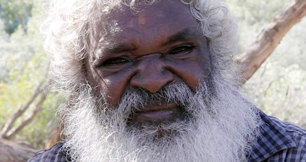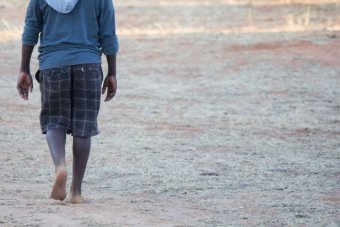Indigenous suicide: Struggling communities get $10 million funding boost
A small, isolated Indigenous community in the Gulf of Carpentaria that has been left reeling from a spate of suicides is set to benefit from a funding boost to a community support service.
The service to prevent Indigenous suicides is getting a $10 million boost as the Government begins to roll it out across Australia.
The project, trialled in Western Australia last year, will be expanded into the Northern Territory and South Australia this year, with the rest of the country to follow in 2018.
Indigenous Affairs Minister Nigel Scullion announced the funding in the remote community Groote Eylandt in the Northern Territory today.
Tony Wurramarraba, chairman of the Anindilyakwa Land Council, said when one person in Groote Eylandt died, everyone was affected.
“Everyone’s related here and everyone knows each other, and it’s very sad when we do lose a young one,” he said.
He said technology and social media had a negative impact on traditional life in the community of about 1,200 people.
“It has been like a trigger, it changes them,” he said.
“Bullying on technology, on mobile phones, talking, sending messages and that sort of stuff … to the young ones when they do get those messages and die, it really has a serious effect on them.
“Our children are dying and we feel helpless.”
Mr Wurramarraba said the suicides were a relatively recent phenomenon and were a result of the disempowerment of communities and elders who once played a much stronger role in disciplining young people.
“Our rights were taken away from us … The powers of the old people were taken away, that’s when everything went downhill,” he said.
Mr Scullion said every suicide was a tragedy and the effects on tight-knit Aboriginal and Torres Strait Islander communities were often more profound, “contributing to the clusters of suicide and self-harm that we see”.
Indigenous suicide rate far higher than in general population
Young Indigenous people take their own lives at five times the rate of other Australians, and in 2014 suicide was the fifth-leading cause of death for Indigenous people.
If you or anyone you know needs help:
- Lifeline on 13 11 14
- Kids Helpline on 1800 551 800
- MensLine Australia on 1300 789 978
- Suicide Call Back Service on 1300 659 467
- Beyond Blue on 1300 22 46 36
- Headspace on 1800 650 890
- QLife on 1800 184 527
The Critical Response Service (CRS) is led by Adele Cox, a Bunuba and Gija woman from WA who has worked in suicide prevention for almost two decades.
“Families are struggling, families aren’t sure where to go,” she said.
“There are so many families and communities who were not being provided with the right sort of support with regard to response times as soon as a suicide or a traumatic incident occurred.”
Members of the CRS team reach out to families affected by suicide and coordinate existing support services to ensure they are delivered in a culturally appropriate way to respond to each family’s particular needs.
Indigenous suicide related to poverty
More than a third of Australia’s youth suicides are Indigenous, and Indigenous children make up 80 per cent of those under 12 who take their own lives, said Indigenous suicide researcher Gerry Georgatos, who works on the Aboriginal and Torres Strait Islander Suicide Prevention Evaluation Project (ATSISPEP).
“The suicide crisis is deepening, abyss-like, and sitting idly by cannot be an option,” he said.
“The firmament of this crisis has occurred because of racism so deep it is institutionalised, that governments, one after another, [turn] the blind eye and deaf ear.”
He said his research showed almost all Indigenous suicides were committed by people living in poverty, and that almost 40 per cent of Indigenous people live below the poverty line.
People fall between the cracks
Senator Scullion said a report the Government commissioned in July confirmed what he saw as he travelled from community to community.
“A myriad of support services delivered by different agencies and not-for-profit organisations but with little coordination between them to make sure families are properly supported in times of great distress,” he said.
“The effect is that people fall between the cracks.”
He said the service was led by communities, and denied the focus on support after a suicide was taking away from suicide prevention.
“You’ll always find a critic, ‘Oh, it’s the ambulance at the bottom of the cliff,’ well, this particular cliff you need something there,” Senator Scullion said.
“This is not an ambulance, it’s a springboard. This is something to catch people at that particular time because we know there is a cliff there and that’s why we responded to it.”
Mr Georgatos said grieving families needed ongoing psychosocial support which was not always available in remote communities.
“Not all the services respond to all suicide trauma-affected families, and some pretend to, while others disengage prematurely,” he said.
“Some service responders work beyond the call of duty, to exhaustion, because others aren’t doing their bit… There is a lot of inauthenticity in the suicide prevention space, but the [service] will help to authenticate and validate a little bit more of it.”
Indigenous-run service for families affected by suicide to be introduced nationwide
Critical Response Service given a $10m boost after a successful trial in Western Australia
23 Jan 2017 – THE GUARDIAN
An Indigenous-run support service for families affected by suicide or trauma has been given a $10m boost after a successful trial in Western Australia, the minister for Indigenous affairs announced at Groote Eylandt on Monday.
The Critical Response Service, which coordinates existing services to properly and culturally appropriately assist families in distress, is set to be expanded into the Northern Territory and South Australia this year before a national roll out.
“Every suicide is a tragedy and the effects on tight-knit Aboriginal and Torres Strait Islander communities are often more profound – contributing to the clusters of suicide and self-harm that we see,” Nigel Scullion told Guardian Australia.
“Straight away we go in where there’s been an event, like Elijah in Kalgoorlie … with these tragic circumstances. They are a trigger and we’ve worked out how triggers gather. Then it’s a critical response services to to go to the family and put them at the centre of the support response.”
The service is funded through the Indigenous advancement strategy and is led by Adele Cox, a Bunuba and Gija woman from the Kimberley region of WA, with extensive experience in suicide prevention work. The West Australian pilot responded to about 30 incidents last year.
Families didn’t know where to go, Cox told the ABC. “There are so many families and communities who were not being provided with the right sort of support with regard to response times as soon as a suicide or a traumatic incident occurred,” she said.
The rate of Indigenous suicide, particularly in remote communities, is among the highest in the world. In Australia the suicide death rate was double that of non-Indigenous people.
Hospitalisations for self-harm and the rates of Indigenous adults reporting high or very high psychological distress rose in the years to 2014-15, according to the Productivity Commission.
Scullion said government reviews had revealed “myriad” support services from different groups and agencies but they did not have adequate coordination. “The effect is that people fall between the cracks”.
The trial in Western Australia, as a component of the Aboriginal and Torres Strait Islander Suicide Prevention Evaluation Project, had been successful in bringing services together, Scullion said.
Scullion said the service would exit an area once the existing services – many government funded – were coordinating better. The government was also implementing mental health first aid training among Indigenous affairs department and sector workers he said.
“It’s about lifting the capacity of communities to understand and help. Have we fixed the environment to reduce poverty? No we haven’t and we have to acknowledge that. We need to work on the precursors.”
A suicide researcher, Gerry Georgatos, said eight in 10 suicides under the age of 12 were Indigenous children. His research showed a direct correlation with living in poverty and high rates of suicide, he said.
The service, which Georgatos is assisting with, was a “step in the right direction”.
“In the end we trialled it for one year in WA and we’ve been able to improve the lives of many affected families,” he said. “But poverty is an ultimate battle. That’s where the suicides are, where the self-harming and aberrant behaviour predominately is.
“Significantly my research says what is almost negligible is the suicides of Aboriginal and Torres Strait Islander people living above the poverty line, and living well, and actually significantly less than non-Indigenous Australians. This signifies the solutions – people who are living well and earning a quid and are Indigenous are enjoying the best of their culture.
“One government after another has failed to adequately respond to the degradation of a lot of these communities I go to.
“It’s a myth that it’s shame and taboo to speak about loss. I’ve sat with hundreds of families across this continent who are Aboriginal and Torres Strait Islander … They pour out their heart. It’s the listening that’s not happening.”




